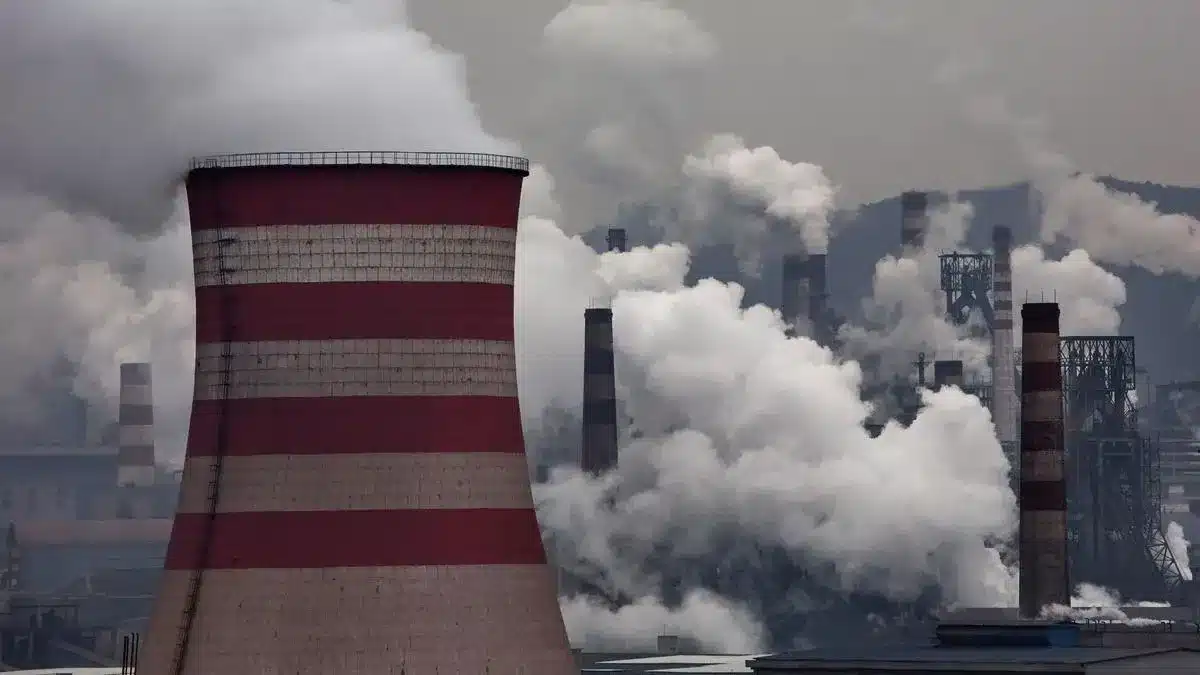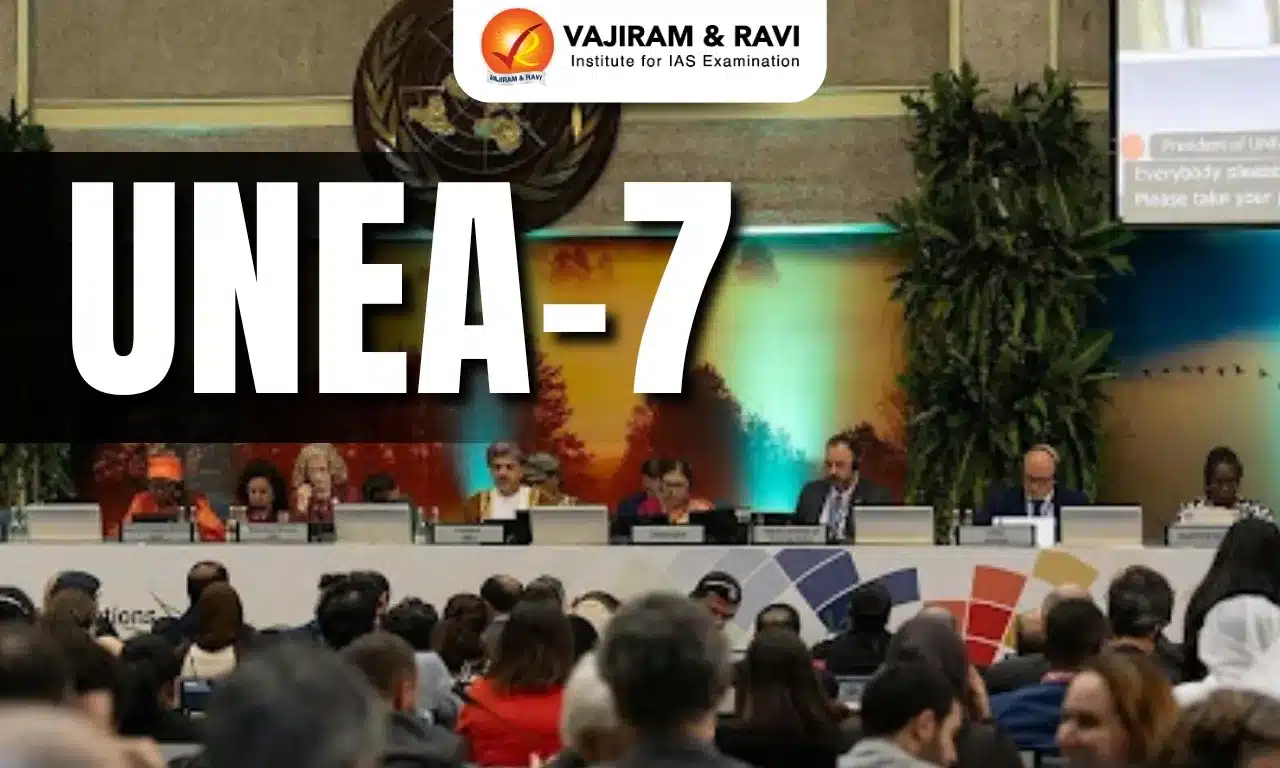What’s in today’s article?
- What is a Carbon Credit?
- How the Carbon Credit Mechanism Works?
- Types of Carbon Credit Markets
- Benefits of the Carbon Credit Mechanism
- Challenges & Criticism
- Carbon Credits in the Indian Context
- News Summary
What is a Carbon Credit?
- A carbon credit represents a permit or certificate granting its holder the right to emit one tonne of carbon dioxide (CO2) or an equivalent amount of another GHG.
- These credits are generated through activities that reduce emissions or remove CO2 from the atmosphere, such as:
- Renewable energy projects like wind or solar farms
- Energy efficiency initiatives
- Reforestation or afforestation projects
- Methane capture at landfills or industrial sites
How the Carbon Credit Mechanism Works?
- Setting Emission Caps: Governments or regulatory bodies establish emission caps for industries or companies.
- Organizations emitting less than their allowed quota can sell their surplus as carbon credits.
- Those exceeding their limits must buy additional credits to comply with regulations.
- Generating Carbon Credits: Credits are issued to projects that demonstrate measurable and verifiable GHG reductions.
- Certification is typically provided by international bodies such as the Verified Carbon Standard (VCS) or the Gold Standard.
- Trading Carbon Credits: Carbon credits are traded on platforms such as the European Union Emissions Trading System (EU ETS) or voluntary markets.
- This trade creates a financial incentive for emission reduction.
- Offsetting Emissions: Organizations can purchase credits to offset their emissions and achieve carbon neutrality.
Types of Carbon Credit Markets
- Compliance Market: Operates under legally binding frameworks, such as the Kyoto Protocol or the Paris Agreement. Companies are mandated to adhere to emission caps.
- Voluntary Market: Allows companies, individuals, or organizations to purchase credits voluntarily to meet corporate social responsibility (CSR) goals or personal commitments to sustainability.
Benefits of the Carbon Credit Mechanism
- Environmental Impact: Encourages adoption of cleaner technologies and sustainable practices.
- Economic Incentives: Rewards projects that actively reduce emissions, fostering innovation.
- Flexibility: Provides industries with cost-effective options to comply with emission targets.
- Global Collaboration: Facilitates cooperation across countries, addressing climate change on a global scale.
Challenges & Criticism
- Verification and Accountability: Ensuring that carbon credits represent genuine and measurable emission reductions can be complex.
- Market Volatility: Prices for carbon credits can fluctuate, affecting market stability.
- Greenwashing: Companies may misuse credits to appear environmentally responsible without making substantive changes.
- Inequitable Access: Developing countries may face challenges in accessing the resources needed to generate credits.
Carbon Credits in the Indian Context
- India, as a developing economy, has significant potential in the carbon credit market:
- Renewable Energy: India’s focus on solar, wind, and hydropower projects aligns with carbon credit generation.
- Afforestation: Programs like the National Afforestation Programme can contribute to offsetting emissions.
- Export Potential: Indian companies can sell surplus carbon credits on international markets, generating revenue.
- Government Initiatives: Policies such as the Perform, Achieve, and Trade (PAT) scheme encourage energy efficiency and the creation of carbon assets.
News Summary
- A new study published in the journal Nature has highlighted the ineffectiveness of carbon trading mechanisms in achieving meaningful emission reductions.
- The study, conducted by researchers from European and American institutions, reviewed thousands of projects responsible for generating carbon credits equivalent to one billion tonnes of carbon dioxide.
- It found that only 16% of these credits corresponded to actual emission reductions.
- Key Findings:
- Kyoto Protocol Mechanisms:
- The majority of credits studied were created under the Kyoto Protocol, the predecessor to the Paris Agreement. These mechanisms, now defunct, have long faced criticism for their lack of integrity.
- Effectiveness by Project Type:
- Projects focused on the abatement of HFC-23 chemicals were found to be the most effective, with 68% of the credits leading to genuine reductions.
- Kyoto Protocol Mechanisms:
- The study emphasized the importance of “additionality” in carbon crediting—ensuring that emission reductions would not have occurred without the revenue from carbon credits.
- However, many existing approaches to assess additionality have led to non-additional projects being registered.
- Recommendations:
- Researchers suggest tightening eligibility for carbon credit projects to those with a high likelihood of additionality and robust financial reliance on carbon credit revenues.
- Standards and methodologies for quantifying emission reductions also need significant improvements to ensure credibility.
- Developments Under the Paris Agreement:
- The carbon market mechanism remains the final element of the 2015 Paris Agreement yet to be fully operationalized.
- New, more stringent frameworks for carbon trade are being designed to address the flaws of the Kyoto-era mechanisms.
- Two Mechanisms Under Development:
- Bilateral Country-Level Trade: Countries exceeding their emission reduction targets can sell credits to others through negotiated agreements.
- International Carbon Market: Open to multiple participants, with institutions being established to regulate, verify, and authenticate the trade of credits.
- Progress at COP29:
- At the ongoing COP29 meeting in Baku, two key rules for carbon markets were approved on the opening day, but substantial work remains.
- These new mechanisms aim to ensure the integrity of carbon credits and enhance their role in combating climate change.
Q1. What is the UNFCCC and what do they do?
The UNFCCC secretariat (UN Climate Change) is the United Nations entity tasked with supporting the global response to the threat of climate change. UNFCCC stands for United Nations Framework Convention on Climate Change.
Q2. What is the difference between mitigation and adaptation?
In essence, adaptation can be understood as the process of adjusting to the current and future effects of climate change. Mitigation means preventing or reducing the emission of greenhouse gases (GHG) into the atmosphere to make the impacts of climate change less severe.
Source: Only 16% of past carbon credits represented actual emission cuts: Study
Last updated on December, 2025
→ Check out the latest UPSC Syllabus 2026 here.
→ Join Vajiram & Ravi’s Interview Guidance Programme for expert help to crack your final UPSC stage.
→ UPSC Mains Result 2025 is now out.
→ UPSC Notification 2026 is scheduled to be released on January 14, 2026.
→ UPSC Calendar 2026 is released on 15th May, 2025.
→ The UPSC Vacancy 2025 were released 1129, out of which 979 were for UPSC CSE and remaining 150 are for UPSC IFoS.
→ UPSC Prelims 2026 will be conducted on 24th May, 2026 & UPSC Mains 2026 will be conducted on 21st August 2026.
→ The UPSC Selection Process is of 3 stages-Prelims, Mains and Interview.
→ UPSC Result 2024 is released with latest UPSC Marksheet 2024. Check Now!
→ UPSC Prelims Result 2025 is out now for the CSE held on 25 May 2025.
→ UPSC Toppers List 2024 is released now. Shakti Dubey is UPSC AIR 1 2024 Topper.
→ UPSC Prelims Question Paper 2025 and Unofficial Prelims Answer Key 2025 are available now.
→ UPSC Mains Question Paper 2025 is out for Essay, GS 1, 2, 3 & GS 4.
→ UPSC Mains Indian Language Question Paper 2025 is now out.
→ UPSC Mains Optional Question Paper 2025 is now out.
→ Also check Best IAS Coaching in Delhi

















